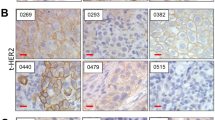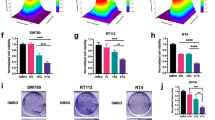Abstract
Previous investigations have revealed that bladder cancer cells are generally resistant to Fas-mediated apoptosis by conventional Fas agonists. However, the ability of these cell lines to undergo Fas-mediated apoptosis may have been underappreciated. As a result, we investigated the in vitro efficacy of Fas ligand gene therapy for bladder cancer. Three human bladder cancer lines (T24, J82, and 5637) were treated with the conventional Fas agonist CH-11, a monoclonal antibody to the Fas receptor. Cells were also treated with a replication-deficient adenovirus containing a modified murine Fas ligand gene fused to green fluorescent protein (GFP), AdGFPFasL. A virus containing the GFP gene alone was used to control for viral toxicity (AdGFP). Cell death was quantified using a tetrazolium-based (MTS) assay. Cells were also evaluated by Western blotting to evaluate poly (ADP-ribose) polymerase, caspase 8, and caspase 9 cleavage and by flow cytometry to determine the presence of coxsackie/adenovirus receptor (CAR). These studies confirmed bladder cancer resistance to cell death by the anti-Fas monoclonal antibody CH-11. This resistance was overcome with AdGFPFasL at a multiplicity of infection (MOI) of 1000 achieving over 80% cell death in all cell lines. Furthermore, greater than 80% cell death was evident in 5637 cells treated with low-dose AdGFPFasL (MOI=10). 5637 cells expressed significantly higher levels of surface CAR than J82 or T24 cells (P<.05). AdGFPFasL is cytotoxic to bladder cancer cells that would otherwise be considered Fas resistant, supporting its in vivo potential. Enhanced sensitivity to AdGFPFasL may be in part due to increased cell surface CAR levels.
This is a preview of subscription content, access via your institution
Access options
Subscribe to this journal
Receive 12 print issues and online access
$259.00 per year
only $21.58 per issue
Buy this article
- Purchase on Springer Link
- Instant access to full article PDF
Prices may be subject to local taxes which are calculated during checkout






Similar content being viewed by others
References
Cookson MS, Herr HW, Zhang ZF, et al. The treated natural history of high risk superficial bladder cancer: 15-year outcome. J Urol. 1997; 158: 62.
Herr HW . Natural history of superficial bladder tumors: 10 to 20-year follow-up of treated patients. World J Urol. 1997; 15: 84.
Suda T, Hashimoto H, Tanaka M, et al. Membrane Fas Ligand kills human peripheral blood T lymphocytes, soluble Fas Ligand blocks the killing. J Exp Med. 1997; 186: 2045.
Suda T, Nagata S . Purification characterization of the Fas-ligand that induces apoptosis. J Exp Med. 1994; 179: 873.
Boldin MP, Varfolomeev EE, Pancer Z, et al. A novel protein that interacts with the death domain of Fas/APO1 contains a sequence motif related to the death domain. J Biol Chem. 1995; 270: 7795.
Micheau O, Solary E, Hammann A, et al. Sensitization of cancer cells treated with cytotoxic drugs to Fas-mediated cytotoxicity. J Natl Cancer Inst. 1997; 89: 783.
Trauth BC, Klas C, Peters AMJ, et al. Monoclonal antibody-mediated tumor regression by induction of apoptosis. Science. 1989; 245: 301.
Rokhlin OW, Glover RA, Cohen MB . Fas-mediated apoptosis in human prostatic carcinoma lines occurs via activation of caspase-8 caspase-7. Cancer Res. 1998; 58: 5870.
Ambar B, Frei K, Malipiero U, et al. Treatment of experimental glioma by administration of adenoviral vectors expressing Fas ligand. Hum Gene Ther. 1999; 10: 1641.
Hedlund TE, Meech SJ, Srikanth S, et al. Adenovirus-mediated expression of Fas ligand induces apoptosis of human prostate cancer cells. Cell Death Differ. 1999; 6: 175.
Hyer ML, Voelkel-Johnson C, Rubinchik S, et al. Intracellular Fas ligand expression causes Fas-mediated apoptosis in human prostate cancer cells resistant to monoclonal antibody-induced apoptosis. Mol Ther. 2000; 2: 348.
Hyer ML, Sudarshan S, Kim Y, et al. Downregulation of c-FLIP sensitizes DU145 prostate cancer cells to Fas-mediated apoptosis. Cancer Biol Ther. 2002; 1: 401.
Voelkel-Johnson C, King DL, Norris JS . Resistance of prostate cancer cells to soluble TNF-related apoptosis-inducing ligand (TRAIL/Apo2L) can be overcome by doxorubicin or adenoviral delivery of full-length TRAIL. Cancer Gene Ther. 2001; 8: 1.
Mizutani Y, Okada Y, Yoshida O, et al. Doxorubicin sensitizes human bladder carcinoma cells to Fas-mediated cytotoxicity. Cancer. 1997; 79: 1180.
Muzio M, Stockwell BR, Stennicke HR, et al. An induced proximity model for caspase-8 activation. J Biol Chem. 1998; 273: 2926.
Adrain C, Martin SJ . The mitochondrial apoptosome: a killer unleashed by the cytochrome seas. Trends Biochem Sci. 2001; 26: 390.
Kaufmann SH, Desnoyers S, Ottaviano Y, et al. Specific proteolytic cleavage of poly(ADP-ribose) polymerase: an early marker of chemotherapy-induced apoptosis. Cancer Res. 1993; 53: 3975.
Stevenson SC, Rollence M, White B, et al. Human adenovirus serotypes 3 and 5 bind to two different cellular receptors via the fiber head domain. J Virol. 1995; 69: 2850.
Freimuth PA . A human cell line selected for resistance to adenoviral infection has reduced levels of the virus receptor. J Virol. 1995; 70: 4081.
Li Y, Pong R, Bergelson JM, et al. Loss of adenoviral receptor expression in human bladder cancer cells: a potential impact on the efficacy of gene therapy. Cancer Res. 1999; 59: 325.
Mizutani Y, Wu XX, Yoshida O, et al. Chemoimmunosensitization of the T24 human bladder cancer line to Fas-mediated cytotoxicity and apoptosis by cisplatin and 5-fluorouacil. Oncol Rep. 1999; 6: 979.
Perabo FG, Kamp S, Schmidt D, et al. Bladder cancer cells acquire competent mechanisms to escape Fas-mediated apoptosis and immune surveillance in the course of malignant transformation. Br J Cancer. 2001; 84: 1330.
Salone B, Martina Y, Piersanti S, et al. Integrin α3β1 is an alternative cellular receptor for adenovirus serotype 5. J Virol. 2003; 77: 13448.
Shimizu H, Akasaka S, Suzuki S, et al. Preferential gene transfer to BBN-induced bladder tumors by simple instillation of adenoviral vector. Urology. 2001; 57: 579.
Kamat AK, Lamm DL . Intravesical therapy for bladder cancer. Urology. 2000; 55: 161.
Lam JS, Benson MC, O’Donnell MA, et al. Bacillus Calmette-Guérin plus interferon-α2B intravesical therapy maintains an extended treatment plan for superficial bladder cancer with minimal toxicity. Urol Oncol. 2003; 21: 354.
Hyer ML, Sudarshan S, Schwartz D, et al. Quantification characterization of the bystander effect in prostate cancer cells following adenovirus-mediated FasL expression. Cancer Gene Ther. 2003; 10: 330.
Acknowledgements
We thank Rick Peppler for acquiring all the flow cytometry data with the use of the MUSC Flow Cytometry Facility equipment. We also thank Dr Jeffrey Bergelson for kindly providing the RcmB anti-CAR antibody. This study was supported by NIH/NIC PO1 CA97132.
Author information
Authors and Affiliations
Corresponding author
Rights and permissions
About this article
Cite this article
Sudarshan, S., Holman, D., Hyer, M. et al. In vitro efficacy of Fas ligand gene therapy for the treatment of bladder cancer. Cancer Gene Ther 12, 12–18 (2005). https://doi.org/10.1038/sj.cgt.7700746
Received:
Published:
Issue Date:
DOI: https://doi.org/10.1038/sj.cgt.7700746
Keywords
This article is cited by
-
Therapeutic approaches targeting CD95L/CD95 signaling in cancer and autoimmune diseases
Cell Death & Disease (2022)
-
Apigenin, a dietary flavonoid, inhibits proliferation of human bladder cancer T-24 cells via blocking cell cycle progression and inducing apoptosis
Cancer Cell International (2015)
-
A Lentiviral Vector Expressing Desired Gene Only in Transduced Cells: An Approach for Suicide Gene Therapy
Molecular Biotechnology (2015)
-
A Novel Double-Enhanced Suicide Gene Therapy in a Colon Cancer Cell Line Mediated by Gef and Apoptin
BioDrugs (2014)
-
miR-708 promotes the development of bladder carcinoma via direct repression of Caspase-2
Journal of Cancer Research and Clinical Oncology (2013)



